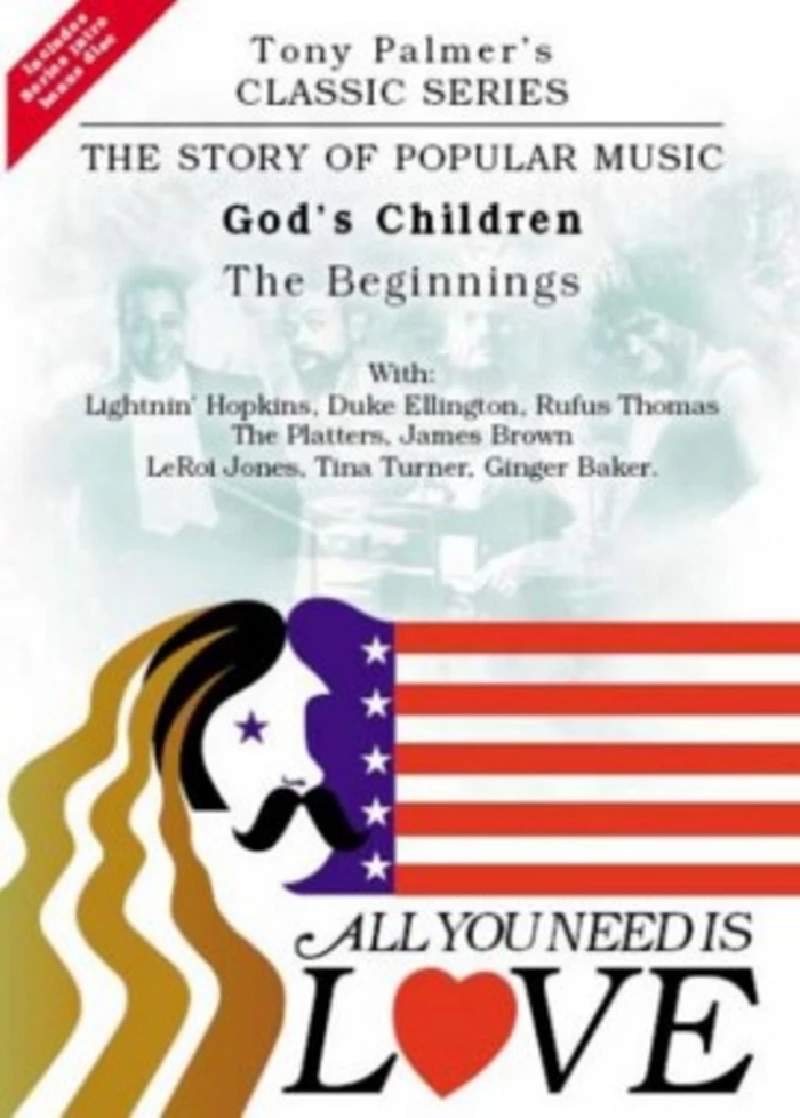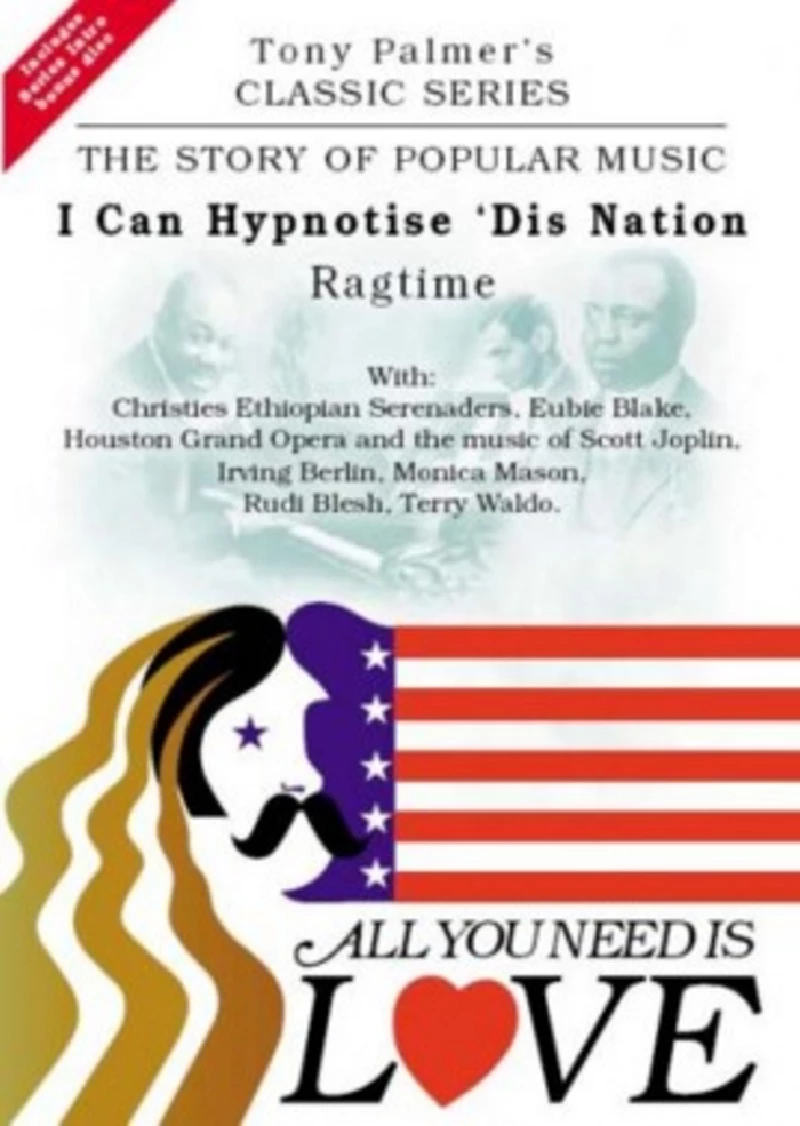Miscellaneous - Volumes 1 and 2
by Lisa Torem
published: 24 / 6 / 2009

intro
Lisa Torem looks at the first two instalments in British film director Tony Palmer's 'All You Need is Love' 17 part 1970's music history series, which have just been re-released on DVD
British film director Tony Palmer first released ‘All You Need is Love'in 1968 and then in 1975, after encouragement from John Lennon, he completed this ambitious series which provides a historical and cultural context for key performers and their influence on popular music. In addition, Palmer attempts to analyze “myths” regarding the time and geographical locations where certain genres developed. For example, Palmer comments that “blues – as a form of music does not appear until 1910 or so, that is after ragtime and jazz.” He adds to that, “Blues is not, therefore, the cornerstone of popular music.” Palmer uses personal interviews, performances and stunning visuals to move the story along. This 17 DVD series with include ‘Introduction Bonus Discs’ is divided into categories such as the following first two DVDs in the series which I will review, ‘God’s Children – The Beginnings’ and ‘I Can Hypnotise Dis Nation – Ragtime.’ Interviewer Paul Oliver wrote the script and intelligently engages the vast range of subjects The strength of the first film is the cameo shots of notables such as Memphis Slim singing, “you said you gonna love me forever, now didn’t you babe?” The up-close and personal choices give the film its emotional intensity. Blues musician, Johnny Verlin, in a moment of pensive thought, says that most blues musicians “try to sing to relieve themselves.” And when describing the Delta sound he adds, “They sang as they work – that’s how they were born…” A magnificent shot of Furry Lewis playing cantankerous slide guitar brings the point home. Blues pianist Roosevelt Sykes sings the maudlin lyrics of ‘St. James Infirmary’, “stretched out on a long, white table…” and explains that most people don’t realize that this song’s roots were based in London. Palmer attempts to answer questions as the film rolls on. A statue of WC Handy in a park near Beale Street in Memphis leads to a narrative in which the narrator describes how Handy could not get his music published (due to racism) so he created his own publishing company. He explains how the railroad which deposited black rural workers to urban regions – Memphis to Chicago – influenced new styles. Case in point, musician Son House abandoned his harmonica for the guitar “because it was louder” and more appropriate for a large congested metropolis which is depicted through cut-aways of flaming steel mills. Wearing a pink suit, Ray Charles appears playing the bluesy-heavy-handed chords of ‘Georgia’. He extols, “basically the blues is three chords – it never gets beyond that.” Then, he reminds the audience of how songwriters and interpreters create the blues pattern,“you notice they say the same thing twice to get your attention.” The outlandish chanteuse Victoria Spivey shows reporter Oliver her white dress which has black, plastic spiders attached and explains how it relates to her signature song. She sings ‘Don’t Trust Nobody Blues’ and when Oliver asks her respectfully to explain the term, “classic blues,” she taunts him by flirtatiously repeating, “I’m very classy – you can see that for yourself.” This scene in which the reserved British journalist clashes with the outspoken American performer provides some comic relief as occasionally the historical references and sensationalist, juxtaposing visuals become a little weighty. There is some rare footage of “The Empress of the Blues,” Bessie Smith. Her producer John Hammond, being driven past the Ahlambra Theater where he had sat through two of Smith’s performances, heralds this comment, “I knew that I had heard the greatest popular singer I had ever heard.” Describing Smith’s spending habits he concludes, “she managed to make a lot of money and spend a lot of money all at the same time.” Hammond also describes singer Billie Holiday, “she sang like an instrumentalist, she improvised as she sang and she was way ahead of her time.” And in regards to her heroin addiction “she never really shook the habit.” A 1958 shot of Holiday shows her singing the touching, self-penned ‘Billie’s Blues’. Her eyes lack lustre and her voice parches, but the undeniable emotion conveys her vulnerability. She sings, “love will make you do things that you know is wrong…” A moving shot of Smith’s gravestone with the inscription “the greatest blues singer in the world will never stop singing,” follows as Hammond explains how Smith bled to death because the ambulance would not immediately drive her back to an urban hospital when she endured a car crash. ”Had she been white she would have been taken to the hospital much sooner,” he says quietly. Barney Josephson discusses how the infamous Cotton Club venue in New York situated the black patrons in the worst seating arrangements, and to address the issue of forced segregation in entertainment establishments, Josephson opened his own club, Café Society. Some scenes revealed the anger musicians felt – Muddy Water explains, “I made him a millionaire – he made me a name,” when discussing why few blues artists achieved material success at this time. Jimmy Dawkins concludes, “it’s just a pissed-off system. We can’t get the proper exposure.” The massive digits of Mighty Joe Young bending notes contrasts clips of the KKK and a diverse racial mix of Americans marching and carrying American flags as the famed Martin Luther King dream speech plays in the background. And another grand glimpse metamorphises when icon B.B. King croons to his beloved guitar Lucille, “The thrill is gone away, you done me wrong and you’re gonna be sorry one day…” There are great moments where Jerry Lee Lewis plays piano with one hand then crouches toward the audience and engages in near obscene word-play. The Stones arriving to a concert – Jagger carrying a green, paper umbrella, donning an extra-long scarf which is tossed casually about his neck and wearing a shirt with flowing sleeves. A shot of pianist Liberace wearing an ornate blue, lame costume, encouraging a group of elderly women to sing along, yields a moment of adorable sweetness. But the funniest moment occurs when DJ Murray the K, in the mid ‘60s, is called to come back to Florida (he’s on vacation) by his producer because,”the Beatles are coming.” “Get an exterminator,” he responds. Dizzy Gillespie’s remarkable trumpet-engorged cheeks, as he sings killer-scat is memorable as is Glen Campbell wearing a Stetson, riding a horse and singing ‘Rhinestone Cowboy’. Touching is a moment where activist-singer Joan Baez muses about the lack of celebrities willing to assist in the anti-war movement. She says, “the world is an absolute wreck. There’s no way to be an optimist.” Another classic moment is when drummer extraordinaire Buddy Rich demonstrates how “they all play” and then how the instrument should be played. A fierce, Zeus-like explosion occurs when he attacks the kit. Cut aways to the bland American vocalist Perry Como contrast with Clapton “chucking and bending” solo notes. The Everly Brothers, in an intimate moment, express the disappointment they felt when talk shows asked them to play, but not speak on TV and how they were stereotyped because they were from the south. “It’s all too fast. They wouldn’t think you could talk,” says one brother. Hoagey Carmichael sits at the keys and explains, “In 1918 to hear a blue note blew my top. What enjoyment that was.” He describes the excitement of the Tin Pan Alley Days when American songwriters shared ideas and opened up publishing houses. Roy Rogers, with a mile-wide smile, talks about his fans. One woman said, “I’ve been watching you since I was a little girl.” To which he replies, “How old are you,” and she says, “I’m 78.” Little Richard does an outstanding, but short performance and a dramatic Edith Piaf appears, dressed in startlingly bleak black. A quick look at gorgeous Paul McCartney with Wings, the Bee Gees and Bo Diddley add flourish. “All You Need is Love Volume Two’ focuses on Eubie Blake, Scott Joplin and Irving Berlin. Stand-outs include “the oldest known piece of film (1898) showing what the cakewalk was really like.” Footage of Joplin’s birthplace and his attempt to sanctify his position in American society are riveting. With a project of such magnitude there’s always going to be questions, such as, what about the forgotten icons like Chuck Barry? And are there some traces of revisionist history taking place? I suspect an American filmmaker might have looked at the context in a different way – especially if he/she had lived through many of these historical episodes. For example, many issues were too simply dismissed as being racial issues, when economics may have caused injustices as well. But, the vast amount of research required to construct these DVDs was worth it – the footage exhibits critical reflections by both cutting-edge performers and those who promoted their talents.
Picture Gallery:-

most viewed articles
current edition
John McKay - InterviewCathode Ray - Interview
Robert Forster - Interview
When Rivers Meet - Waterfront, Norwich, 29/5/2025
Spear Of Destiny - Interview
Fiona Hutchings - Interview
Carl Ewens - David Bowie 1964 to 1982 On Track: Every Album, Every Song
Chris Wade - Interview
Shrag - Huw Stephens Session 08.12.10 and Marc Riley Session 21.03.12
Brian Wilson - Ten Songs That Made Me Love...
previous editions
Heavenly - P.U.N.K. Girl EPBoomtown Rats - Ten Songs That Made Me Love....
Manic Street Preachers - (Gig of a Lifetime) Millennium Stadium, Cardiff, December 1999
Allan Clarke - Interview
Oasis - Oasis, Earl's Court, London, 1995
Barrie Barlow - Interview
Beautiful South - Ten Songs That Made Me Love...
Pixies - Ten Songs That Made Me Love...
Chuck Prophet - Ten Songs That Made Me Love...
Dwina Gibb - Interview
most viewed reviews
current edition
Peter Doolan - I Am a Tree Rooted to the Spot and a Snake Moves Around Me,in a CircleVinny Peculiar - Things Too Long Left Unsaid
Garbage - Let All That We Imagine Be The Light
Vultures - Liz Kershaw Session 16.06.88
John McKay - Sixes and #Sevens
Little Simz - Lotus
HAIM - I Quit
Pulp - More
Lapsley - I'm a Hurricane, I'm a Woman In Love
Billy Nomates - Metalhorse
Pennyblackmusic Regular Contributors
Adrian Janes
Amanda J. Window
Andrew Twambley
Anthony Dhanendran
Benjamin Howarth
Cila Warncke
Daniel Cressey
Darren Aston
Dastardly
Dave Goodwin
Denzil Watson
Dominic B. Simpson
Eoghan Lyng
Fiona Hutchings
Harry Sherriff
Helen Tipping
Jamie Rowland
John Clarkson
Julie Cruickshank
Kimberly Bright
Lisa Torem
Maarten Schiethart